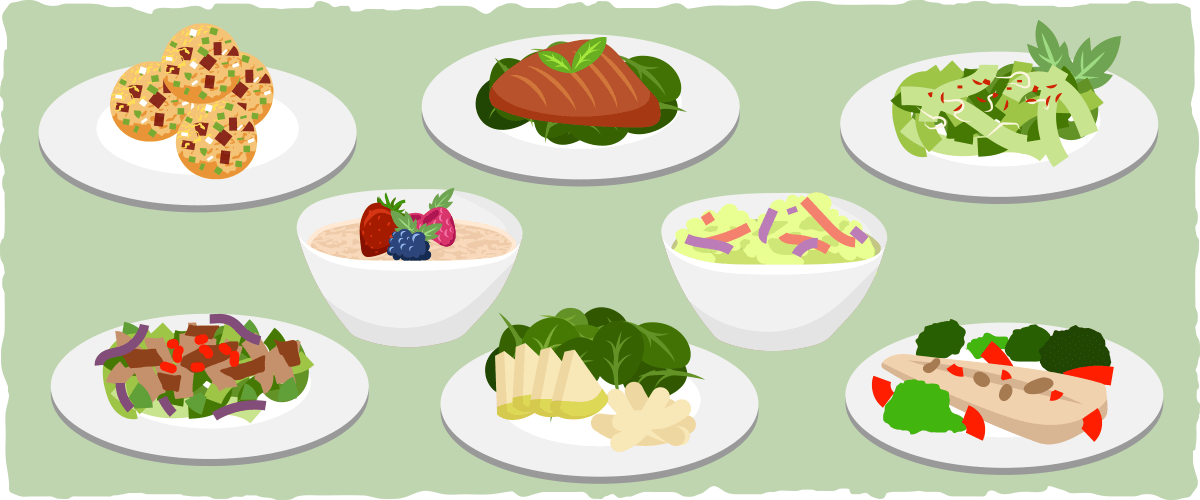We all naturally fall somewhere on the spectrum between squeaky clean keto and dirty lazy keto — even if we aren’t aware of it.
The way of eating that you end up following ultimately depends on two crucial factors: (1) how healthy, sustainable, and effective the diet is for you and (2) the values that drive your decisions (e.g., your budget, your health, religious beliefs, environmental/animal welfare concerns, and anything else that you prioritize when making a decision about what to eat).
In this comprehensive guide to dirty vs. clean keto, we will take these key factors into consideration as we discover what keto approach may be best for you. For your convenience, we’ve included a clickable list of the topics we’ll be covering:
- Clean vs. dirty keto — what is the difference?
- What is lazy, dirty keto? A simple definition
- Dirty keto vs. lazy keto: Is there a difference?
- The risks and benefits of going dirty
- Lazy keto food list
- Dirty, lazy keto recipes and meal plan template
- What is clean keto?
- Clean keto food list
- Clean keto recipes
- Benefits and downsides of going clean
- Lazy and clean keto: Is it the best version of the keto diet?
- Key takeaways and free keto resources
Clean vs. Dirty Keto — What is the Difference?
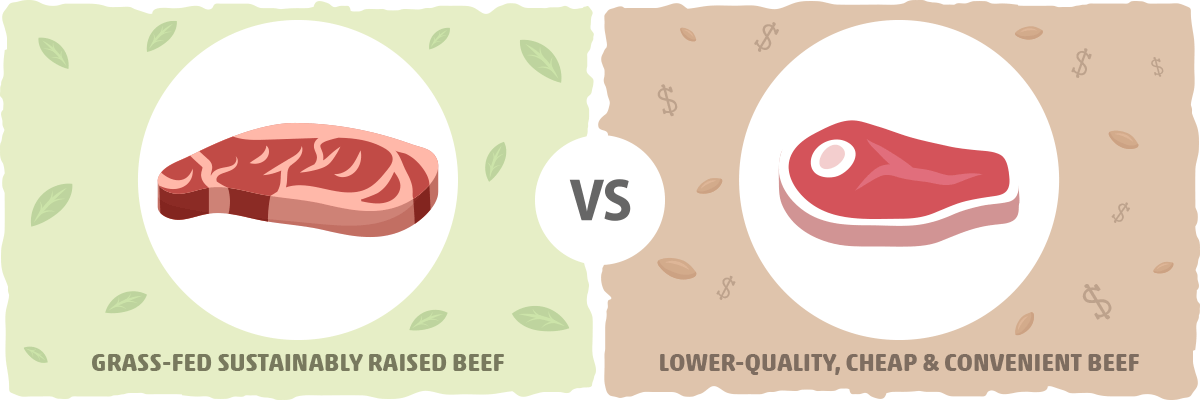
Dirty vs. clean diets naturally evolve out of how we prioritize what we value most when it comes to making food choices.
On one side of the spectrum, we have the clean keto diet. With this approach, high-quality keto-friendly foods take the wheel, while convenience and expense sit in the back.
Instead of getting just any kind of beef, for example, squeaky clean keto dieters will go out of their way to find 100% grass-fed and grass-finished beef that is raised sustainably. In contrast, someone on a dirty lazy keto diet will go with whatever beef is the cheapest and easiest to consume.
On dirty lazy keto, convenience and cost are the key concerns. In this case, food quality doesn’t matter nearly as much as eating cheap and convenient keto-friendly foods.
In general, where you fall on this clean-dirty keto spectrum will depend on how your diet affects your health and body composition as well as how sustainable it is for you, your bank account, and the environment in the long run. To help you find the ideal approach for you, let’s take a closer look at these two keto diet variations.
What is Lazy, Dirty Keto? A General Overview
With this keto diet approach, the primary focus is eating the right amount of macronutrients from fat, protein, and carbs to stimulate and maintain ketosis.
It doesn’t matter what you eat to get there, as long as you do. This approach is pretty seductive because almost anything goes as long as the carbs are low.
Want a fast-food burger? Indulge as you wish — Just make sure you ditch the bun, sugary ketchup, and sauce.
Want fried cheese wrapped in bacon that is wrapped in fried cheese and another layer of bacon? Go for it (and you can even fry it in butter if you’d like)!
The Difference Between Dirty Keto vs. Lazy Keto
Dirty keto and lazy keto are often treated as if they are interchangeable. However, the terms “lazy” and “dirty” refer to different characteristics of the diet that are worth understanding as you develop your keto lifestyle.
Essentially, a “lazy” approach is one that prioritizes your convenience. In other words, this diet will be formulated in a way that makes it as easy as possible for you to lose weight and improve overall health. Most diets can be followed in a lazier way, including keto and other low carb diets.
In contrast, dirty keto is focused on eating high fat, low carb foods that’ll help promote ketosis. Other nutrients, such as vitamins, minerals, and fiber, aren’t taken into consideration.
Lazy and dirty are often combined into the same diet because low-quality, dirty foods are usually more convenient for our budgets, busy schedules, and taste buds. (As we’ll learn later, however, high-quality clean keto foods can be incorporated in a lazy way as well.)
On dirty lazy keto, you can easily meet your macronutrient needs without touching a vegetable or cooking a single meal. Unfortunately, this straightforward diet approach comes with several potential downsides despite the fact that it can help us lose weight and improve some aspects of health.
The Risks and Benefits of Going Dirty with Your Keto Diet
The dirty keto approach receives a great deal of criticism, but it does have its benefits. Depending on where you start, this simple and convenient diet strategy can be used to help you take a step toward improving your health, losing weight, and cleaning up the eating patterns you are trying to change.
Since keto requires you to keep carbs as low as possible, it is nearly impossible to fit common diet staples (such as bread, pasta, sugar, flour, potato chips, candy, soda, juice, and cereal) into your meals. For some, this simple shift in food choices can be all they need to lose weight, reduce cardiovascular disease risk, decrease blood sugar levels, and improve overall well being.
Another potential benefit for many keto beginners is that a dirty keto diet can be cheaper and more convenient. Since your food decisions only depend on how keto-friendly a food is (will this fit into my carb limit and macros for the day?) and how cheap the food is (will this fit into my budget?), it will be easier to make the change to a keto lifestyle.
Keep in mind, however, that if your diet is already relatively clean, then the benefits you experience from dirty keto will be much more limited. Going from clean to dirty is not recommended, but the occasional dirty meal won’t cause you to lose all of your progress.
Using dirty, lazy keto as your primary way of eating is not recommended either. Though you will save money and time in the short-term, this approach will not be ideal for your overall health. This is because eating low-quality, keto-friendly food comes with the following risks:
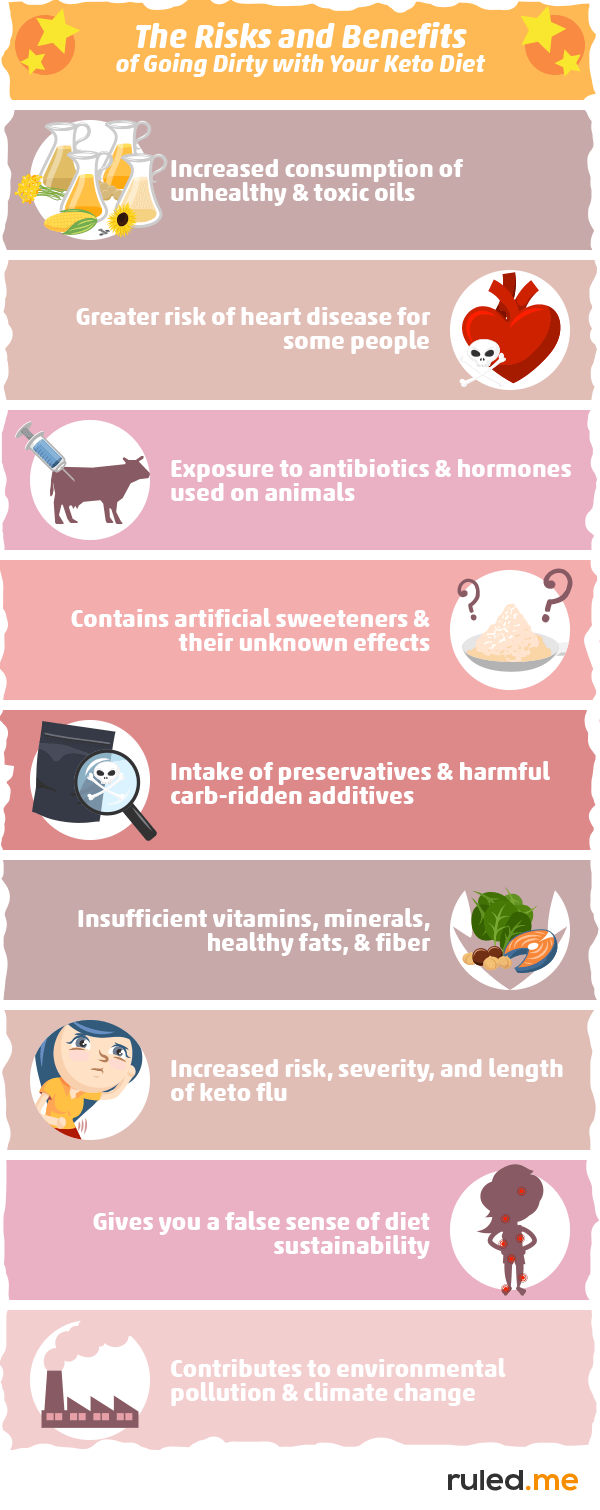
- Increased consumption of unhealthy, toxic oils. Refined vegetable and seed oils (like soybean oil, canola oil, corn oil, and sunflower oil) are riddled with toxic compounds that set the stage for chronic inflammation and an increased risk of cardiovascular disease, type 2 diabetes, Alzheimer’s disease, and more. Cooking and frying with the unrefined varieties of these oils will create these toxic compounds as well. If you’d like to learn more about healthy fats to eat and cook with on keto, read through our guide on good vs. bad fats.
- Greater risk of heart disease for some people. Cheap and convenient keto foods tend to be higher in saturated fat — a type of fat that can worsen cholesterol levels and increase cardiovascular disease risk for some people. To find out if your approach to keto is improving your heart health, check out our in-depth article on keto and cholesterol.
- Increased exposure to antibiotics and hormones used to produce conventional animal products. Although you may only get trace amounts of antibiotics and hormones, they may still affect your health and encourage the creation of antibiotic-resistant bacterial infections. Opting for antibiotic-free and hormone-free is recommended to prevent this from happening.
- More artificial sweeteners and their unknown effects. By relying on cheap and convenient low-carb foods, you will increase your exposure to artificial sweeteners, such as sucralose, aspartame, and saccharin. Current evidence suggests that they are toxic to gut bacteria and can increase sugar cravings, weight gain (indirectly), and cardiovascular disease risk for certain populations. Artificial sweeteners are also emerging as significant environmental pollutants.
- Increased intake of preservatives and other potentially harmful, carb-ridden additives. Be on the lookout for suspicious ingredients found in processed foods. Many seemingly harmless ingredients might trigger negative symptoms or contain more net carbs than expected. Below, you can find a list of items detailing this.
- Decreased intake of vitamins, minerals, healthy fats, and fiber. The likelihood of developing a vitamin or mineral deficiency on keto increases significantly when we rely on cheap and convenient options. It is crucial to include a wide variety of different foods, especially whole plant foods, in your diet. This can be more expensive and inconvenient at times, but it is much easier than trying to chase away the symptoms of a micronutrient deficiency.
- Increased risk, severity, and length of keto flu. Without an adequate intake of minerals, vitamins, healthy fats, and fiber, you will increase your likelihood of experiencing headaches, cramping, digestive issues, fatigue, and other common keto flu symptoms.
- Gives you a false sense of diet sustainability. Although you can lose weight and improve health with this approach, your results will be limited. Without cleaning up your food choices, you can increase the risk of various health issues including chronic inflammation, digestive disorders, and heart disease. Low-quality keto food can only take you so far.
- Contributes to environmental pollution and climate change. Not only can a dirty keto approach increases the risk of future health issues, but it will accelerate the degradation of our natural environment. Excessive use of synthetic fertilizers, antibiotics, hormones, pesticides, and herbicides to produce cheaper food sacrifices the long-term health of our environment for short-term profitability.
Some hidden sources of net carbs in “keto-friendly” products include:
- Isomaltooligosaccharides (IMOs) — may be listed as a prebiotic fiber in keto products, but research continues to show that it is digested as a net carb.
- Dextrose
- Maltodextrin
- Polydextrose
- Any derivative of starch
Some additives that have been associated with negative symptoms:
- Propylene glycol
- Propyl gallate
- Potassium sorbate
- Polysorbate 80
- Natamycin (a mold inhibitor)
- Sodium metabisulfite
- Sodium benzoate
- Sodium nitrate and/or nitrite
- MSG
- Food dyes
- Phthalates and other chemicals from BPA and BPA-free plastics
Amidst these downsides, dirty lazy keto can still be useful when used as a short-term strategy for one of two reasons:
- To help you transition from a highly-processed diet filled with carbs and fat to a cleaner keto way of life (without breaking your budget or causing you to descend into decision fatigue insanity).
- To help you stay in ketosis from meal to meal when cleaner options aren’t available.
If you need some help getting started with keto or sticking to keto when you have limited options, check out the dirty keto food list and meal plan we’ve included below.
Lazy, Dirty Keto Food List: What to Eat and What to Avoid
The most convenient, dirty keto staples:
- Full-fat conventional dairy. This includes cheese, heavy cream, cream cheese, and butter. The conventional variety of these products are produced using practices that aren’t ideal for the animals, the environment, or your health. Cleaner dairy options include products from grass-fed, sustainably-raised cows and other sustainably raised animals or the dairy-free butter that you’ll find in our guide to dairy-free keto.
- Processed/packaged meat and seafood. Though fresh and sustainably-raised sources are best, there is still a place for bacon, jerky, smoked fish, canned seafood, and other packaged products in your keto diet. Just make sure to check labels for hidden carb sources, artificial preservatives, and other additives.
- Pork rinds, nuts, seeds, and other packaged keto-friendly snacks. You’ll find that some keto snacks are more costly than others. To help you find a convenient option that fits within your budget, check out our healthy keto snack list.
- On-sale salad greens. Get the cheapest greens you can find, throw some leftover meat and cheese on top, and you’ll have a quick, easy, and relatively clean keto meal.
Dirty keto foods that should be limited:
- Pre-packaged and processed keto-friendly products (that you know are keto-friendly for you). Just because the packaging on some processed foods and snacks boasts being keto-friendly, this doesn’t mean it’s a good idea to eat them. Always make sure to check the ingredients for hidden carb sources (like those we mentioned in the previous section). Your best bet is to rely on minimally-processed foods without any added ingredients.
- Low-carb fast food. Though most of the menu will be riddled with carbs, it is possible to get your fast food fix while on keto. We put together an extensive list of keto-friendly options that you can find in our keto and fast food guide. Keep in mind, however, that you are likely to find more convenient, healthier, and cheaper on-the-go options on our keto snack list.
Dirty keto foods that should be avoided:
- Margarine and other partially or fully hydrogenated oils. These artificial trans fats should be avoided at all costs. Even small doses of these fats can significantly increase your risk of heart disease.
- Refined plant-based oils. Most oils that are derived from plant foods are filled with vulnerable fats known as polyunsaturated fatty acids. During the refining and cooking process, many of these fatty acids will be converted into toxic compounds that provoke inflammation.
- Burnt/charred meat, fish, or vegetables. Those burnt ends are undeniably carcinogenic. If you can’t resist the occasional BBQ, make sure to marinate the meat in fresh herbs and spices, and eat it with some raw low-carb veggies. This can help protect you from the damaging effects of these foods.
Below, you will see a graphic summarizing a lazy, dirty keto food list that you can refer back to:
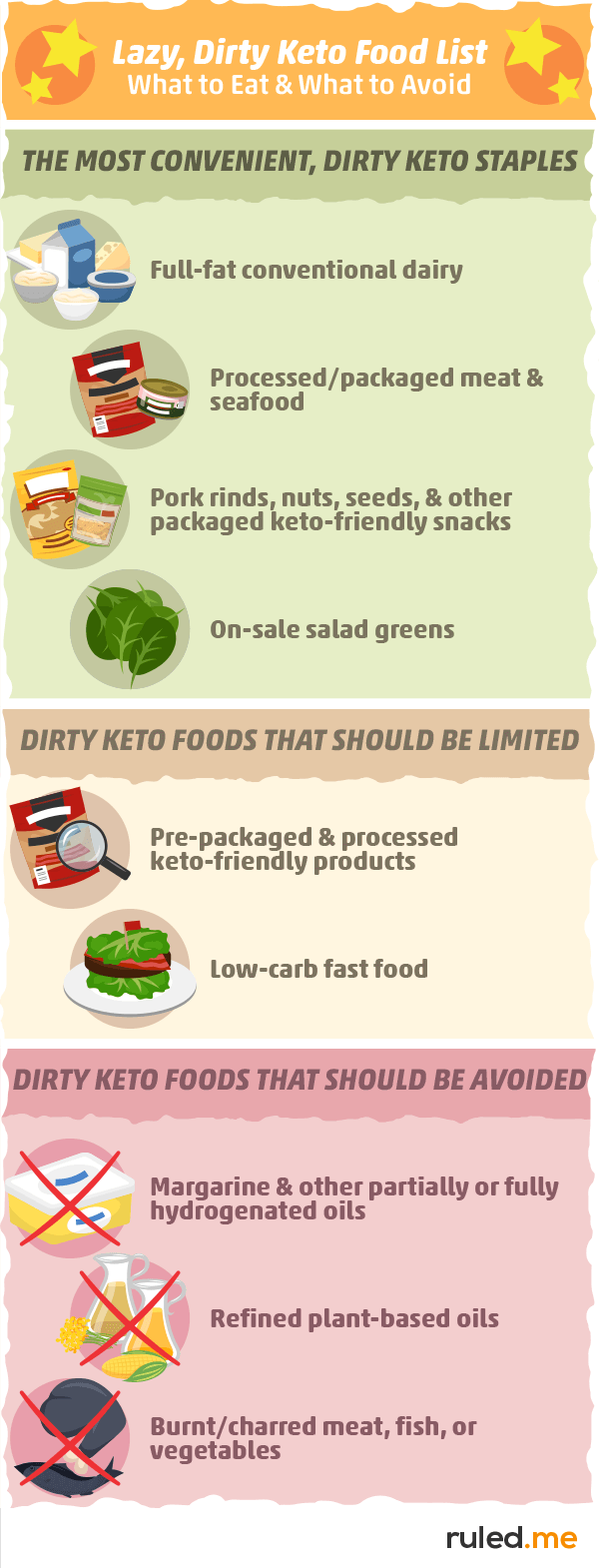
As mentioned earlier, dirty keto should only be used as a transitional step toward a cleaner and healthier way of eating. To help you take the next step, we put together a list of some of our simplest keto favorites.
Dirty, Lazy Keto Recipes (that are Cleaner Than You Think)
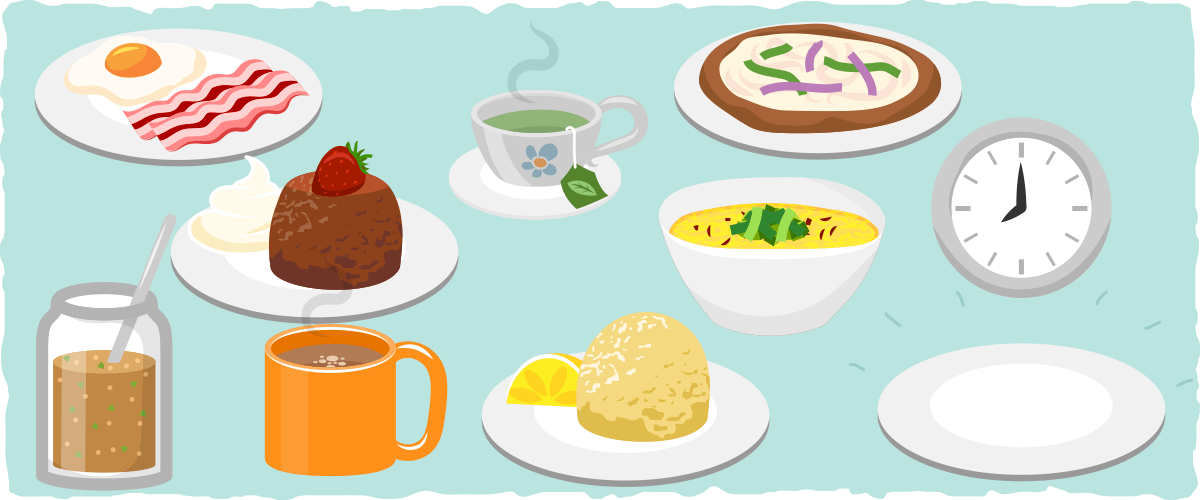
Here is a collection of some quick and easy keto meals — perfect for keto beginners and anyone who is tight on time and money.
Keto Bacon and Eggs
Arguably the simplest keto meal — bacon and eggs. Filling, tasty, and very low in carbs. To save some extra money and time, skip the cream and just crack the eggs on a butter-covered, preheated pan. Scramble the eggs up while they cook. You can also cook the bacon ahead of time and store it in the fridge for up to 4 to 5 days. With these two simple hacks, your meal will be ready in 5 minutes or less.
Savory Mug Cakes
For the quickest of keto meals, try making a savory mug cake for breakfast, lunch, or dinner. They can be made in under 5 minutes and usually call for keto ingredients that you’ll use throughout your keto journey. Once you get the hang of making mug cakes, feel free to experiment with ingredients you have on hand to save even more time and money. Here is a list of our favorite savory mug cakes to get you started:
- Bacon, Cheddar & Chive
- Green Chile Cheddar Mug Cake
- Sun Dried Tomato Pesto Mug Cake
- Cumin Sesame Lemon Mug Cake
- Jalapeno Popper Mug Cake
Sweet Mug Cakes
If you’d like to switch it up with something sweet and filling, try making a sweet mug cake instead. Here are some of our favorites:
- Chai Spice Keto Mug Cake
- Churro Mug Cake
- Maple Pecan Keto Mug Cake
- PB & Chocolate Chunk Mug Cake
- Coconut Chocolate Mocha Mug Cake
- Vanilla Whisky Keto Mug Cake
A Simple Salad with Keto Leftovers
Got some leftover meat and cheese that you don’t want to waste? Toss it on some salad greens for lunch or dinner. To save money on your veggies, try looking for leafy greens that are on sale and have them throughout the week with some of your meals. If you need some extra flavor try whipping up one of our 5 minute keto dressings:
- 5 Minute Keto Raspberry Vinaigrette
- 5 Minute Keto Pesto
- Keto 5 Minute Caesar Dressing
- Or simply use a bit of vinegar with extra virgin olive oil or MCT oil.
5 Minute Keto Pizza
Yes, you read that correctly — keto pizza in 5 minutes. As is the case with the mug cakes, this recipe relies on some cheap and versatile keto ingredients, so your money won’t go to waste. You can also customize it with any of your favorite toppings that you have on hand.
5 Minute Keto Egg Drop Soup
Eggs are the perfect keto food in so many ways. They are cheap, versatile, and packed with fat, protein, vitamins, and minerals. This egg drop soup is just one of the many ways you can incorporate these superfoods into your keto diet.
Ketoproof Coffee (or Tea)
By adding some quality fats to your morning tea or coffee, you can create a cheap and easy “meal” that will keep you energized through lunch and prevent hunger from taking over your mind. Try replacing breakfast with ketoproof coffee (or ketoproof tea) to see how it works for you.
Intermittent Fasting
Intermittent fasting is a popular diet strategy that can be added to any eating plan. All you have to do is skip a meal or two. Many keto dieters implement intermittent fasting by skipping breakfast, but you can design your eating and fasting window in whatever way that works best for you. This dieting strategy will encourage your body to feast on stored fat, providing you with the most convenient and cheapest of keto meals.
Dirty, Lazy Keto Meal Plan Template
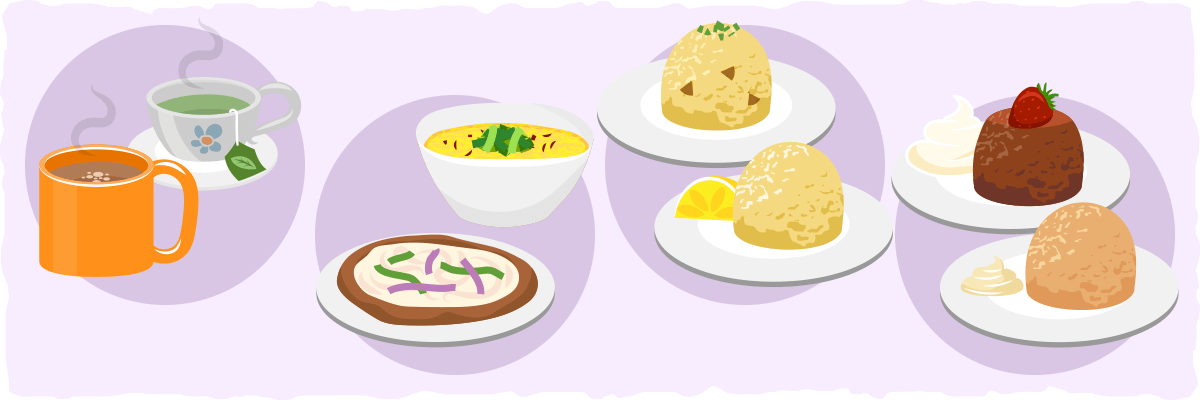
For a Typical Work Day:
Breakfast: Fast through the morning or have 1-2 cups of ketoproof coffee or tea.
Lunch: Select an option from the list below (prepare the night before and take it to work with you):
- 5 Minute Keto Pizza
- 5 Minute Egg Drop Soup
- A simple salad with leftover meat
- Continue your fast or have another cup of ketoproof coffee or tea
- Combine a few keto snacks into a meal
Dinner: Select an option from the list below and have it with a side salad or any other low-carb vegetable that fits within your budget:
- 5 Minute Keto Pizza
- 5 Minute Egg Drop Soup
- Bacon, Cheddar & Chive
- Green Chile Cheddar Mug Cake
- Sun Dried Tomato Pesto Mug Cake
- Cumin Sesame Lemon Mug Cake
- Jalapeno Popper Mug Cake
- Keto Bacon and Eggs
Dessert: To save some money and time, we recommend skipping dessert altogether.
However, if you need a quick fix for your sweet tooth, whip up one of these mug cakes:
- Chai Spice Keto Mug Cake
- Churro Mug Cake
- Maple Pecan Keto Mug Cake
- PB & Chocolate Chunk Mug Cake
- Coconut Chocolate Mocha Mug Cake
- Vanilla Whisky Keto Mug Cake
For the Weekend or a Non-work Day:
Breakfast: select an option from the list below:
- Fast through the morning
- Ketoproof coffee or tea
- Keto Bacon and Eggs
Lunch: select an option from the list below:
- Continue your fast or have another cup of ketoproof coffee or tea
- 5 Minute Keto Pizza
- 5 Minute Egg Drop Soup
- Bacon, Cheddar & Chive mug cake
- Green Chile Cheddar Mug Cake
- Sun Dried Tomato Pesto Mug Cake
- Cumin Sesame Lemon Mug Cake
- Jalapeno Popper Mug Cake
- Keto Bacon and Eggs
- A simple salad with meat or seafood on top
- Combine a few keto snacks into a meal
Dinner and Dessert: Same options as your workday. Feel free to experiment with new dinner recipes, keto sides, and desserts.
Please Note: We created this to give you an idea of what dirty, lazy keto looks like. You will need to adapt the serving sizes and meal options to meet your specific needs. To help you do this, put your info into our keto calculator and adjust your meals accordingly.
The above information should only be used as a step toward a way of eating that is healthier for you. The next step is to clean up different aspects of your diet.
What is Clean Keto? A Simple Definition
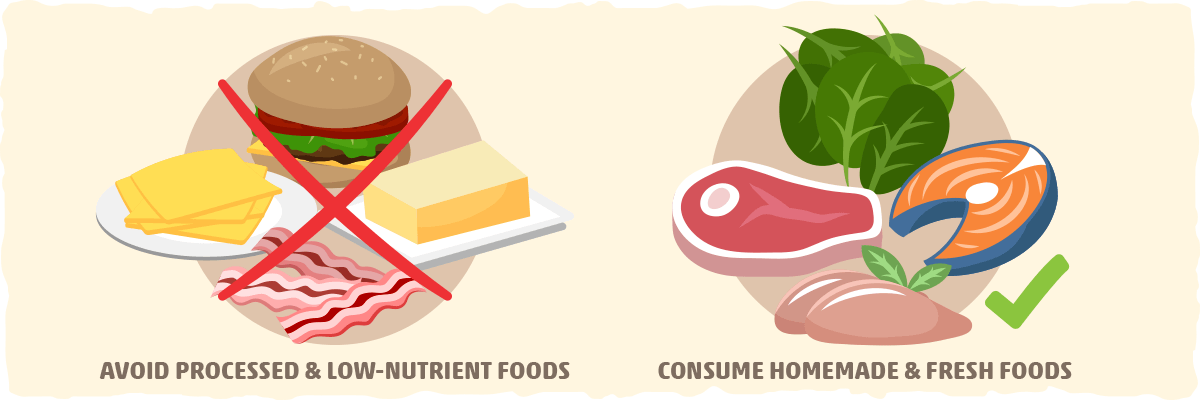
A clean keto diet focuses on low carb foods that are minimally-processed, packed with nutrients, and produced sustainably. Keeping the carbs low enough to stimulate ketosis is still crucial, but a greater emphasis is placed higher quality foods.
With this approach, it is not recommended to persist on butter, processed cheese, bacon, and fast food burgers. Instead, all the meals are homemade with fresh meat or seafood and low carb vegetables.
Clean keto also encourages us to read between the lines of how our food was produced. Rather than simply asking “is this keto-friendly?” we must also consider things that aren’t always found on food labels. This includes the health of the animals and plants, the environmental impact of food production, and the long-term health benefits of investing in higher quality food.
Clean Keto Food List
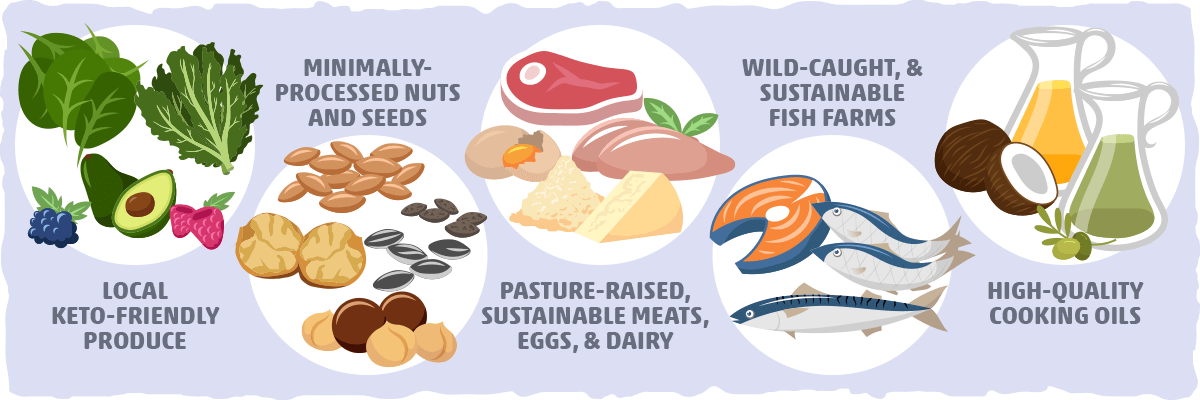
To give you a better idea of what a clean keto diet looks like, here are the cleanest examples of keto staples:
- Local and biodynamic/”beyond organic” keto-friendly produce — buying local low-carb vegetables and fruit grown in a sustainable way will promote optimal health for you and your local environment. Consult our low-carb vegetable list and keto-friendly fruit guide for some ideas, and plug in your location on Eat Wild and Local Harvest to find the highest quality food in your area.
- Minimally-processed nuts and seeds – Nuts and seeds are packed with fiber, micronutrients, and variety of healthy fats that are crucial for keto success. Just make sure to keep track of their net carb content. Some of the lowest carb nuts and seeds are macadamias, walnuts, sunflower seeds, chia seeds, and flaxseeds.
- Pasture-raised, sustainable meats, eggs, and dairy — Look for farmers that raise their animals in a humane way that also help regenerate the environment. Two great examples of this are White Oak Pastures and Polyface Farms. By eating meat, eggs, and dairy from animals like these, you can improve your health and the health of the environment at the same time.
- Wild-caught, sustainable fish — Some of the healthiest options in this category are wild-caught salmon, mackerel, and sardines. They are packed with omega-3s, minerals, vitamins, and antioxidants while also being relatively low in mercury content. Vital Choice will ship fresh, wild-caught fish to your door. Wild Planet also has many wild-caught canned fish products that you can find in various grocery stores, on amazon.com, or on their website.
- High-quality cooking oils — Recent research has found that extra virgin olive oil and coconut oil are least vulnerable to oxidation at high temperatures, with extra virgin olive oil being the most stable and healthiest option. Find a good source of extra virgin olive oil, buy in bulk, and feel free to cook with it and drizzle it on your keto meals to boost the flavor and healthy fat content of your diet.
Clean Keto Recipes
For Breakfast
When you want something other than another egg dish for breakfast, this will be your saving grace. The combination of seeds, nuts, and coconut in this recipe will provide you with several types of healthy fat while the berries come through with a tasteful experience of sweet and tart. What a great way to start the day!
These breakfast bombs are a great way to fit some extra omega-3s, health-promoting herbs, and nutrient-dense eggs into your diet. Don’t forget to have it with the Hollandaise sauce.
For Lunch
Keto Crunchy Thai Chicken Salad Bowl
After having this meal, you may end up craving salad for lunch like me. The flavors from the chicken marinade, almonds, fresh herbs, and olive oil come together beautifully, making this one of the tastiest clean keto lunches.
Keto Crispy Ginger Mackerel Lunch Bowl
This is one of the most delicious ways to add some fish into your keto diet. In this lunch bowl, you’ll also get plenty of fiber, vitamins, minerals, and healthy fats from the broccoli, sun-dried tomatoes, peppers, roasted almonds, and avocado.
For Dinner
Low Carb Walnut Crusted Salmon
This salmon dish checks all the boxes for the keto Mediterranean diet. It is delicious, easy to make, and packed with healthy fats from the salmon, walnuts, and olive oil. You can’t go wrong with this keto dinner.
Zucchini Ribbons & Avocado Walnut Pesto
The zucchini noodles are not only packed with fiber and micronutrients, but they are the perfect vehicle for transferring all of the delicious pesto flavors into your mouth as well. Feel free to add some pasture-raised chicken or wild-caught salmon to increase the protein content and make it even more filling
For Sides
Fiesta Slaw with Avocado Lime Dressing
The avocado lime dressing is so tasty that you’ll wonder why people don’t eat clean all the time. You can even turn it into a full meal by adding any meat you’d like.
If your dinner seems a little lifeless, try whipping up this quick and easy keto salad. It is packed with healthy fats, fiber, vitamins, and minerals. Feel free to use whatever greens you prefer (e.g., baby kale, arugula, and sweet baby lettuce).
Other Options: Clean-up Any Meal From the Dirty Keto Meal List
You can also make any of your favorite dirty keto meals healthier by making them with high-quality ingredients from the clean keto food list. Feel free to add fasting or ketoproof coffee into your clean keto diet as well.
The Benefits and Downsides of Going Clean with Your Keto Diet
If you’ve already read the section on the risks and downsides of a dirty keto diet, then you have a good idea of what cleaning your diet up can do for you. Avoiding the dirty downsides is the main benefit of going clean.
Eating clean can also help you get more out of your keto diet, from boosting your weight loss results to improving heart health. If you’d like to take a look at the research on the health effects of a cleaner keto diet, check out our in-depth article on the Meditteranean keto diet. This is one of the cleanest variations of the keto diet with some high-quality studies backing its benefits.
Despite all of the good that clean keto can do for you, livestock, and the environment, it is hard to ignore the time commitment and financial pressure of making such a giant leap. So, instead of taking a giant leap, start with small steps. Below, we summarize the differences between a lazy, dirty keto diet and a clean keto diet:
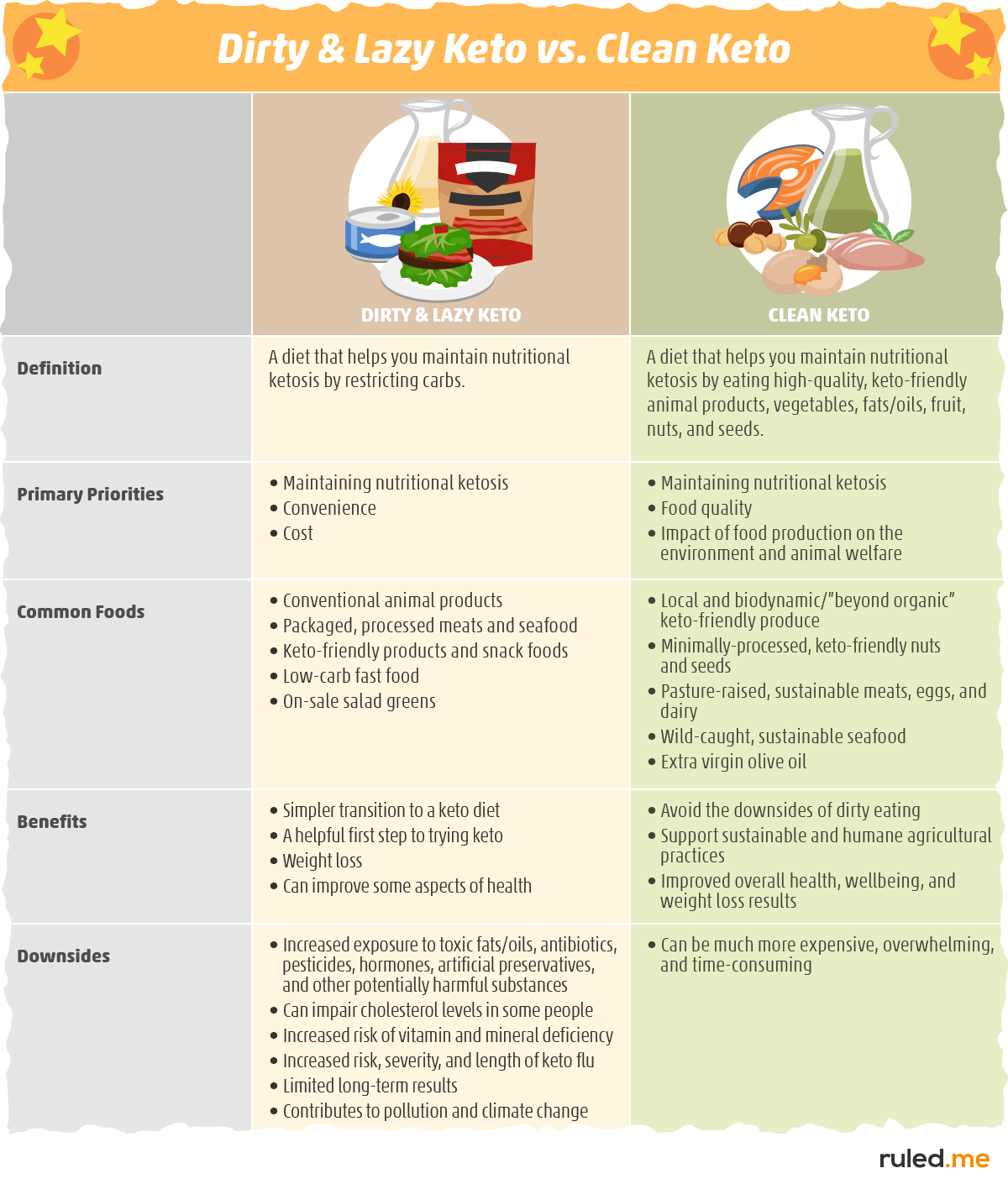
As with any diet, the best approach is one that you can maintain. To help you in your efforts to make cleaner choices that are sustainable for you, we put the two sides of dirty and clean keto spectrum together so you can use their principles to map out your keto journey.
A Lazy & Clean Keto Diet: How to Get the Best of Both Sides
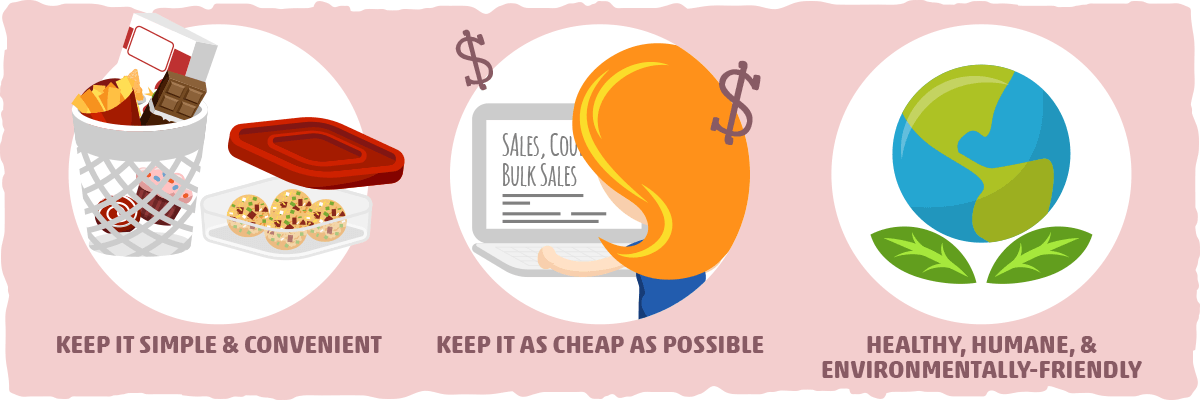
Though clean keto is typically branded as being expensive and inconvenient, it is possible to have the best of both worlds: a diet that is clean, convenient, and relatively cheap.
To do this, you will have to keep these three principles in mind while you make your food choices:
- Keep it simple and convenient. Make it easier for yourself to choose cleaner options. Practical strategies for this principle include removing unhealthy foods from your home, having high-quality keto snacks while you are on the go, and putting a few hours aside each week for meal prep. To help you implement this principle, check out our video guide to meal planning and batch cooking.
- Keep it as cheap as possible. Clean can also be cheap, but you’ll need to do more research beforehand to find the best deals. Practical strategies that can help you with this principle are planning your meals around what’s on sale, buying in bulk, and buying in bulk directly from local farmers. For more money-saving tips, check out our guide to eating keto on a budget.
- Keep it as healthy for yourself, the animals involved, and the environment as possible. Follow the suggestions from the clean keto food list and make changes that you can fit into your lifestyle. Focus on making small and sustainable changes, rather than massive diet overhauls. For more ideas on what adjustments you can make, check out the “Shopping Tips for Health-Conscious and Environmentally-Friendly Ketogenic Dieters” section of our keto shopping list.
This can be a lot to juggle at first, so don’t worry if you drop the ball a few times. These mistakes will provide you with valuable insights into how you can make your diet healthier and more sustainable.
Key Takeaways: Making the Change that is Right for You
Whether you follow a dirty or clean keto diet (or anything in between), what matters most is how sustainable it is for you. Make sure to check in with your mental health, your physical health, and your body composition while you are making any diet change.
If any of these aspects worsens after 1-2 months, then it is best to make an educated adjustment and see how that works for you.
In general, getting cleaner as you go along will lead to the best overall results for you and the environment. That being said, having an occasional dirty meal (or even a high carb food) will not demolish all the progress you’ve made.
Ultimately, your results will be determined by the sum of the choices you’ve made, not by that one dirty meal you had yesterday. If most of your decisions are taking you closer to a cleaner and healthier lifestyle, then you are on the right track (even if the scale doesn’t show it right now).
To help you on your journey toward creating a keto diet that is sustainable for you, we put together a list of helpful resources:
- Keto recipes for breakfast, lunch, dinner, dessert, and everything in between
- Keto calculator for personalized macros
- How to eat keto on a budget
- Sample keto diet shopping list with recipes and budgeting tips
- Keto diet video guides and recipes
- How to figure out if keto is right for you
- How to maintain weight loss results for life
Sources
- The Ketogenic Diet and Diabetes — Ruled.me
- The Ketogenic Diet and Cholesterol — Ruled.me
- The Ketogenic Mediterranean Diet: Optimal Health and Weight Loss — Ruled.me
- How to Lose Weight on a Ketogenic Diet — Ruled.me
- Antibiotics In Animal Feeds — NCBI
- Sugar substitutes: Health controversy over perceived benefits — NCBI
- Measuring Artificial Sweeteners Toxicity Using a Bioluminescent Bacterial Panel — Molecules
- Gastrointestinal Tolerance and Glycemic Response of Isomaltooligosaccharides in Healthy Adults — NCBI
- Evaluation of Chemical and Physical Changes in Different Commercial Oils during Heating — Acta Scientific Nutritional Health
